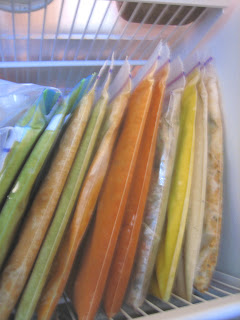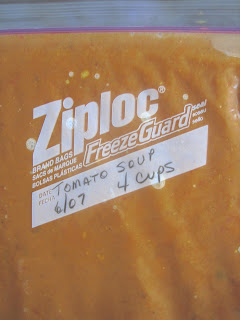The other day when Cherrie and I attended a cooking class, we were served Tortilla Soup. That got me to thinking that all my leftover turkey could be put to good use in a big batch of this soup. Sarah’s soup was very easy, requiring only about 45 minutes of preparation, perhaps. I liked her soup very much – it hit the spot on a nice, cool day. But having made Tortilla Soup many times before, I decided to pull together several recipes that I have. My usual go-to recipe is from America’s Test Kitchen, and I’ve made it lots of times. At the moment, the recipe is available, but you have to register (free) to use their site. Their recipe is a bit more complex than this soup, but the flavors are similar. I like a variety of vegetables in my tortilla soup, so this time I added corn, and celery. If I’d had some zucchini, I’d have added that too.
If you still have some turkey in the freezer, from Thanksgiving, this would make a lovely use for it. It’s delicious. You can make your own tortilla chips, if you have the tortillas fresh. Otherwise, just use packaged, but crush them up a little bit on top of the soup when it’s served. I had about a quart of drippings and stock from the turkey. All that went into my soup pot with the fat scraped off. That gave a little different depth of flavor to the soup. The dried chiles I chose are ones that give more flavor than heat – guajillo and ancho. Since I have a collection of dried chiles in my pantry, I make notes on the package so I know which ones lend heat and which ones do not. Then I added a single Jalapeno chile at the end to give the soup some heat. If you don’t have any fresh Jalapeno on hand, use a little bit of chipotle instead.
If I haven’t mentioned it before, once I open a can of chipotle in adobo sauce, I put little mounds of it on foil, then pop it in the freezer. Once frozen, I pull the little mounds off the foil and chuck the whole batch in a freezer bag and back in the freezer. That way I can pull out as much as I want. Chipotle goes a looooong ways, so be careful if you’ve not used it before.
If you don’t want heat, eliminate the Jalapeno and remove all the seeds from the dried chiles (if there’s any heat in them, most of it will come from the seeds). With fresh chiles, a lot of the heat is in the ribs, but once chiles dry, most of the ribs disappear.
This soup was just outstanding. Probably because of the flavorful turkey broth. Here’s one of my big helpful hints: whenever you serve turkey, remove most of the turkey meat first and set aside. Break up the bones and put in a tall stockpot. Add water (and an onion, a carrot or two, a clove of garlic, some parsley) to cover. Heat it on the stove until it’s a simmer, cover, then put into a 225 oven (yes, 225). You want the pot to just barely simmer for hours and hours. The lid is on, so you won’t lose any of the fluid. Bake overnight – or for about 18 hours. Or 12. Or 10. Whatever your overnight timing needs to be. Remove from oven, take lid off and allow it to cool. Remove all the bones, strain, then place on the stove and bring to boiling. Continue to boil until the liquid has reduced by at least half or 3/4. I usually end up with about 3-5 cups of concentrated turkey broth. Cool, chill, remove the fat. Then you’re ready to use it.
printer-friendly CutePDF
Files: MasterCook 5+ and MasterCook 14 (click link to open in MC; 14 contains photo)
Turkey Tortilla Soup
Servings: 12
For the Soup:
Source: a compilation of several recipes
3 tablespoons vegetable oil, or olive oil
3 cups onions, diced
2 cups celery, diced
2 cups frozen corn, Trader Joe’s “roasted”
6 cloves garlic, minced
8 cups chicken broth, or turkey broth, or combination
29 ounces canned tomatoes, diced
2 large guajillo or ancho chile peppers, dried, broken up (remove seeds if desired)
1 jalapeno chile, seeded, diced (optional)
4 cups turkey, diced or shredded
Garnishes:
1 cup Monterey Jack cheese, shredded
2 whole limes, cut in wedges
2 whole avocadoes, ripe, diced
1 cup fresh cilantro, chopped
3 cups tortilla chips
Sour cream (optional)
1. Dice up the onions, celery and garlic. Heat the oil in a large stockpot and saute the onions for about 3-5 minutes, then add celery. Continue cooking for about 5 minutes, then add garlic and stir frequently for about 1 minute.
2. Add the turkey or chicken broth, canned tomatoes with their juice and the dried chiles. Bring to a boil and simmer for about 15 minutes, then add the roasted corn. Simmer for 5 minutes, remove from heat and allow to cool. If possible make this one day ahead to this point.
3. Reheat soup. Meanwhile, chop up all the garnishes. You may either serve the garnishes on the side and allow people to add what ones they prefer, on top, or you may put the desired garnishes in the bowl first, then pour hot soup on top. Sprinkle with tortilla chips (crushed in your hands first) on top with a little bit of cilantro.
Per Serving: 619 Calories; 35g Fat (48.9% calories from fat); 27g Protein; 55g Carbohydrate; 7g Dietary Fiber; 55mg Cholesterol; 1063mg Sodium.












Leave a Comment!